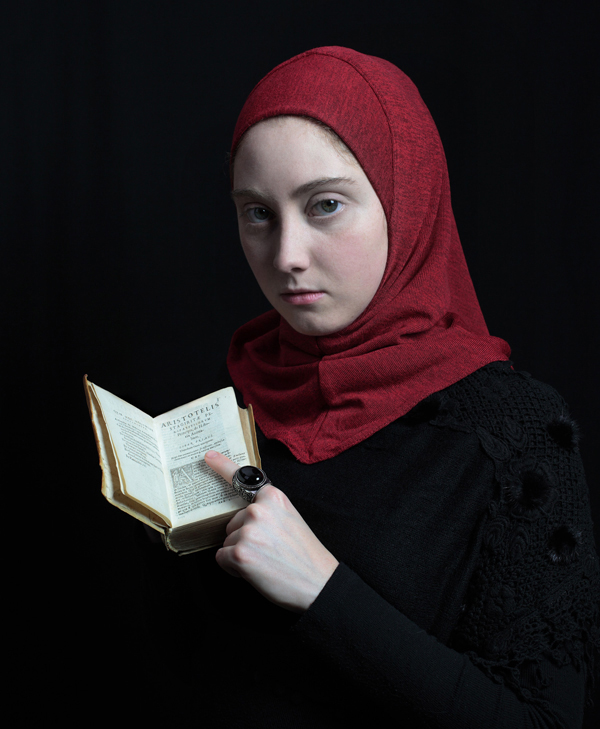Carla Iacono: Re-velation

© Carla Iacono
Re-velation:
Exhibition curator: Stefania Zorzi
Visit the exhibition Re-velation >
English / Italian
With the photographic series Re-velation Carla Iacono deals with the delicate issue of the manipulation of cultural differences, starting with the analysis of the situation of Muslim women immigrated to Europe and focusing on the hijab, the Islamic veil that frames the face and only covers the hair.
The veil used by Muslim women has been and will continue to be subject of debate for many years;
precisely the plurality of attributable meanings and the evocative power of the veil have turned it into an emblem object of social, political, religious and cultural debates, despite being a symbol present in many cultures.
In Europe, in the discussion on the secular state, the Islamic veil is often considered an attack on the principles of secularity and equality, thus becoming the subject of media debates and a real "veil of discord".
On the other hand, facing the laws that prohibit it, many Muslim women are appealing to the rights and freedom of expression/religion to be allowed to wear it. The veil has thus become the bearer of new meanings and ways of expression, related to the issues of citizenship, cultural claims, search for new spiritual models; it reflects, especially for migrant women, the need to stay connected to their country and their families as a representation of their culture of origin.
Re-velation includes images in which the veil, constant element in the portraits, is declared in different ways: mainly hijabs, but also Catholic and Jewish veils as well as Eastern European headscarves, with references to the specific cultures.
From the formal point of view, the compositions are reminiscent of classical portraits, creating a symbolic contamination between the different culture of the East and the West: the images recall the iconography of Western portraits but often the subject wears oriental veils / accessories.
The portraits all have the same protagonist, the artist's young daughter; this autobiographical element contributes to emphasize the representation and makes it a genuine testimony. The subjects are photographed against a uniformly dark background that often is confused with the dresses. The side light makes the figures emerge from darkness revealing the facial features and the details of the veils, thus symbolically and visually reinforcing the concept of revelation.
According to the artist, it is a female prerogative to face, with levity but determination, complex and sensitive problems; in Re-velation Carla Iacono does not take a position on the use of the veil, but delves into history to "reveal" a whole range of values and meanings with sincere and refined images, in complete respect of the differences and similarities between cultures.
It is a personal contribution to urge the observer to reflect and take the side of "others"; and if that is enough to cause a graceful and passionate discussion on the subject, the goal will be achieved.
English / Italian
Con la serie fotografica Re-velation, Carla Iacono affronta il delicato tema della manipolazione delle differenze culturali, a partire dalla situazione delle donne musulmane immigrate in Europa, concentrandosi principalmente sullo hijab, il velo islamico che incornicia il volto, coprendone solo i capelli.
Sul velo delle donne islamiche si discute da sempre; proprio la pluralità di significati attribuibili e il potere evocativo lo hanno trasformato in oggetto emblema di dibattiti sociali, politici, religiosi, culturali, nonostante sia un simbolo presente in molte culture.
In Europa, nell’ambito del dibattito sulla laicità dello Stato, il velo islamico è spesso considerato simbolo di attacco ai principi di laicità e uguaglianza, diventando così oggetto di dibattiti mediatici e trasformandosi in un vero e proprio “velo della discordia”. D’altro canto, dinanzi alle leggi che lo vietano, molte donne musulmane immigrate si appellano ai diritti e alle libertà di espressione/religione per poterlo indossare. Il velo è diventato così portatore di nuovi significati e modi di esprimersi, legati alle questioni della cittadinanza, alla rivendicazione culturale, alla ricerca di nuovi modelli spirituali; in particolare per le donne migranti spesso rispecchia l’esigenza di rimanere legate al proprio paese e alle proprie famiglie rappresentandone la cultura di provenienza.
Re-velation riunisce immagini in cui il velo, elemento conduttore, è declinato in diversi modi: principalmente hijab, ma anche veli cattolici, ebraici e foulard dell’Europa dell’Est, con richiami alle varie culture.
Da un punto di vista formale le composizioni ricordano i dipinti classici, creando una contaminazione simbolica tra cultura Orientale e Occidentale: le immagini richiamano l’iconografia del ritratto occidentale ma spesso il soggetto indossa veli/accessori orientali.
I ritratti hanno tutti la stessa interprete, la figlia dell’artista; l’elemento autobiografico ne enfatizza la rappresentazione e la rende genuina testimonianza. Le figure sono fotografate su uno sfondo scuro che a volte si fonde con gli abiti, e spesso la luce laterale fa emergere la figura dal buio, rivelando i contorni del viso e i dettagli dei veli e rafforzando così esteticamente e simbolicamente il concetto di rivelazione.
Secondo l’artista è prerogativa femminile affrontare con levità ma determinazione i problemi complessi e delicati; in Re-velation Carla Iacono non prende una posizione sull’uso del velo, ma scava nella storia per “rivelare” tutta una serie di valenze e significati con immagini sincere e raffinate, nel pieno rispetto delle differenze e delle somiglianze tra le culture.
È un personale e sentito contributo per sollecitare l’osservatore a riflettere e a porsi dalla parte degli “altri”; e se ciò basterà a far discutere con garbo e passione dell’argomento, l’obiettivo sarà raggiunto.